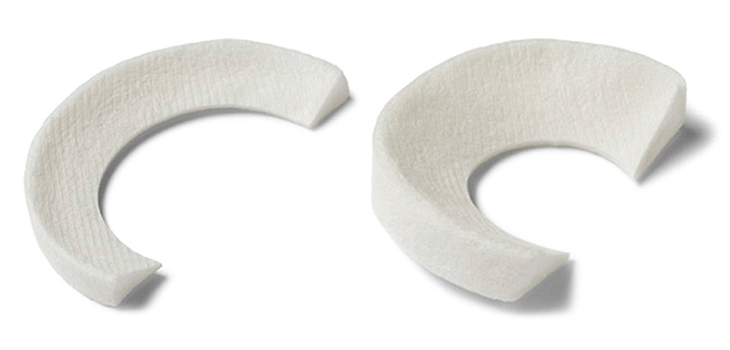The meniscus is a C-shaped piece of cartilage located between the thigh bone (femur) and shin bone (tibia) in the knee joint. Menisci act as shock absorbers and provide stability to the knee. Damage or tears to the meniscus due to injury or age-related wear and tear can cause pain and decrease mobility. Often small tears are treated with physical therapy but larger or degenerative tears require surgery. Traditionally, damaged parts of the meniscus were surgically removed (partial meniscectomy). However, removing too much meniscal tissue can increase the risk of osteoarthritis. A newer treatment option is a collagen meniscus implant which aims to replace damaged meniscal tissue and preserve knee function long term.
What is a Collagen Meniscus Implant?
A collagen meniscus implant is a medical device made from purified collagen from bovine (cow) Achilles tendons. The fibers of the collagen are organized in a manner that mimics the inner and outer portions of the native human meniscus. The collagen meniscus implant comes sterile and pre-sized in various diameters to match individual patient anatomy. During arthroscopic knee surgery, the damaged parts of the meniscus are removed and the collagen implant is sutured in place to act as a scaffold. Over time, the body incorporates the implant and new meniscal tissue grows within it.
Benefits of Collagen Meniscus Implant
The main goal of a Collagen Meniscus Implant is joint preservation by replacing lost meniscal tissue rather than completely removing it. This offers several potential advantages:
– Reduces Pain – By distributing load across the knee joint similarly to a healthy meniscus, the implant aims to reduce pain from excess pressure on bone-on-bone contact areas.
– Prevents Osteoarthritis – Partial or complete meniscectomy increases risks for early osteoarthritis by overloading joint surfaces. An implant preserves meniscal coverage to maintain joint biomechanics.
– Enhances Mobility – Maintaining knee cushioning and stability provided by the meniscus allows for a fuller range of motion and less limitation of activities.
– Delays or Avoids Future Surgery – Properly functioning knee joints have less need for further interventions like arthroplasty (joint replacement).
Surgical Technique and Recovery
Surgeons perform Collagen Meniscus Implant via arthroscopy, using small incisions and cameras to guide suture placement. Once surgically resected tissue is removed, the appropriately-sized implant is secured into place using sutures. Post-operatively, patients follow similar recovery protocols as other arthroscopic procedures with weight bearing restrictions, physical therapy, and return to normal activities within 3-6 months on average. Success rates of implants have steadily improved as surgical experience has grown.
Studies on Clinical Effectiveness
Several long-term clinical studies have evaluated the efficacy of collagen meniscus implants versus partial meniscectomy alone. In a 10-year follow up trial, patients receiving the implant reported better knee function scores, less radiographic osteoarthritis progression, and fewer additional surgeries compared to those only undergoing meniscectomy. Similarly, a randomized controlled trial found significantly lower rates of osteoarthritis and fewer reoperations at 5 years post-surgery for the implant group. While further research continues, current evidence suggests collagen meniscus implantation provides superior functional outcomes to simply removing damaged meniscal segments long term.
Promising New Treatment but Not for All Cases
As the largest clinical trials on collagen meniscus implants reach 10-15 years of follow up data, they demonstrate the potential for the procedure to delay osteoarthritis development, improve knee function substantially, and maintain joint integrity superiorly compared to partial meniscectomy. However, implants are not universally recommended and certain exclusion criteria apply such as advanced arthritis, malalignment issues, or rim width tears extending beyond the vascular zone of the meniscus that cannot be adequately secured. For appropriate candidates with substantial loss of meniscal tissue, collagen meniscus implantation appears a very promising new treatment alternative to joint preserving rather than joint destructive surgeries of the past. Continued research will further delineate best candidate selection and long term implant durability.
Future Directions
While existing studies clearly validate benefits of collagen meniscus implants over removal alone, further research continues on multiple fronts:
– Comparing Implants to Other Options – New prospective, randomized trials comparing implants to other joint preserving strategies like meniscal allografts could help define optimal methods.
– Material Science Advancements – Novel biocompatible scaffold materials and engineered composite constructs aim to enhance biologic ingrowth and mechanical properties over generations.
– Imaging Techniques – Improved diagnostic MRI sequences may better detect subtle early osteoarthritis changes and evaluate long term implant incorporation.
– Outcome Measure Tools – Validated patient reported outcome surveys and activity tracking metrics provide deeper insights into treatment effects on function and quality of life.
– Economics Evaluations – Rigorous cost analyses coupled with long term follow up help demonstrate cost effectiveness and value propositions of joint preserving strategies compared to replacements over patient lifetimes.
Collagen meniscus implantation represents an innovative solution for localized meniscal defects seeking to avoid arthritis onset. As technology and medical knowledge progress, refinements continue improving tissue substitutes to optimally replace damaged structures and postpone joint failure. With judicious patient selection and experience growth, this therapy shows staying power as a preferred treatment paradigm for the knee joints of tomorrow.
*Note:
1. Source: Coherent Market Insights, Public sources, Desk research
2. We have leveraged AI tools to mine information and compile it



